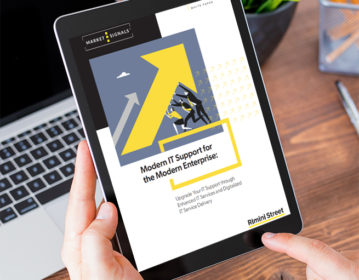
In 1988, General Motors built an expensive relaunch campaign around the tagline, “This is not your father’s Oldsmobile.” As we contemplate the 2027 future state of ERP, does it seem as if some vendors are pinning their hopes on a similar marketing spin? Hopefully, they’ll have more success than GM, whose campaign killed the century-old brand just over five years later.
Analysis
Many of today’s ERP installations will no doubt continue to chug along in 2027 — replacing them is simply too painful a process for some, or the ROI doesn’t seem to justify the cost. But on the vendor side, it’s just as certain what they sell in five years will likely look, feel, and work differently than what customers are accustomed to..
Of late, ERP vendors have been busy embedding bright shiny objects in their roadmaps, seemingly aimed at enticing customers to upgrade or migrate, as well as keeping up with or getting ahead of competitors. Here’s what we see on the ERP pathways ahead, beyond the immediate focus of enticing customers to the cloud.
What to watch for
ERP Trend: Composable Architecture is the way to go
According to a Gartner® report, “A composable ERP approach can enable the organization to achieve efficiency and agility in line with digital business goals.”[1]
Many businesses are seeking to consolidate multiple ERPs, often acquired through M&A, but a single monolithic solution for most is a costly, high-risk approach. Instead, they should focus on composable architecture, advanced integration, and cloud to achieve maximum interoperability and flexibility with common solutions for common functional requirements across the enterprise.
“Composite architecture is one of the emerging trends predicted to drive technological innovation in the next 5-10 years,” explains Anthony Cecchini, president and CTO of the Information Technology Partners consulting firm. “This is an innovation that is agile by design, enabling quick adaptation to business environment changes. Composite architecture forms the foundation of composable ERP.”
ERP Trend: Low Code/No Code provides agility that CIOs desperately need
“Legacy ERP systems are often described as inflexible monoliths that can’t be updated at the speed of business simply because of the way they have been designed,” CIO points out. “With the recent shift to agile software development and the general democratization of IT enabled by advances such as low-code or no-code development environments, companies can change that.”
Adopting low code/no code approaches likely will go hand-in-hand with composable architecture in breaking up monolithic ERPs by speeding up coding and even putting building and testing applications into the hands of users and business analysts. “By eliminating custom code, 67% of IT workers believe they will have more time to dedicate to other tasks/efforts as they are no longer maintaining the most valuable custom code at the organizations,” writes ASUG CEO Geoff Scott in summarizing SAP customer research.
But if you’re looking for easy solutions, here are words of caution from Vaidya Aiyer, CEO of Pillir, a prominent provider of a cloud-native low-code development platform: “Most no code and low code vendors assume that the majority of enterprise applications have available APIs and documented endpoints built into their platforms to facilitate integration with apps. Although this may apply to SaaS and recently developed applications, it’s certainly not the case for legacy in-house applications and ERP solutions that often have been running for 10 to 20 years or more.”
ERP Trend: Artificial Intelligence and Machine Learning will streamline ERP
No forecast can overlook the potential for Artificial Intelligence (AI) and Machine Learning (ML) to advance the cause of any existing technology, including ERP.
“The use of AI in ERP will radically change the way business data and processes are managed,” declares Ted Rohm, senior ERP analyst with Technology Evaluation Centers (TEC). “ERP systems will no longer require people’s efforts and intelligence to properly code and enter every minute detail of a business transaction to complete an operation.” Examples of AI in ERP “include interactive chatbots, intelligent process automation, and AI-infused financial planning,” he adds.
“AI-enabled ERP solutions can help businesses streamline complicated ERP processes with applications such as ML models and conversational AI systems. As business leaders realize that they invest more in AI-enabled ERP applications,” writes industry analyst Cem Dilmegani of AIMultiple. “With increased interest in AI, every major ERP vendor claims to have integrated AI capabilities in their offering.”
ERP Trend: Open-Source ERP is Great for simple/small use cases
“Open source software (OSS) is so prevalent that it’s difficult to imagine life without it,” exclaims VentureBeat tech journalist Paul Sawers. “For businesses, open source brings scalability, transparency, cost savings, and the power of the crowd.”
Open source has disrupted every silo across the enterprise, so it should be no surprise it is creeping into the world of ERP. Who can argue with free software, and access to the crucial source code that proprietary vendors generally keep under lock and key? Still, for an enterprise, open source comes with its own costs, ranging from third-party professional support to staffing up internally, or both.
Smaller organizations without complex requirements may be able to make the switch relatively easier, but for larger companies with years of customizations, adoption of open-source ERP is likely not a near-term option. Still, as more and more companies explore modernization and migration options, open-source options may eventually become more attractive.
ERP Trend: Cloud/SaaS has a place but isn’t right for everyone
For many organizations cloud-based ERP is still very much a future state. On-premises ERP had a 70% market share in 2021, but cloud solutions will dominate the market by 2030, according to Grand View Research. The pendulum will continue to swing toward SaaS ERP, but some big hurdles have yet to be jumped. For example, in many organizations, the continuous control and robust data security that come with a perpetual license model will continue to outweigh the potential for flexibility and agility in subscription models. Likewise, in many organizations, existing ERP complexity can’t yet be replaced by the functional scope of SaaS ERP.
Overall, whatever flavor, ERP remains a booming industry, projected at a $93.34 billion market by 2028, according to Fortune Business Insights.
Action to Take
“ERP systems aren’t going away any time soon,” writes Alan Pelz-Sharpe, founder of the Deep Analysis advisory firm. “They are far too well embedded to rip and replace and decades of development mean they now run complex, repetitive processes effectively.” Pelz-Sharpe predicts that in a world that is increasingly open to adopting IoT, blockchain, and AI, more beneficial, adaptable and affordable solutions to common process challenges are not far off. Be prepared to reengineer, reframe, and rethink your traditional ERP systems.
[1] Gartner, “What CIOs Must Do to Avoid Disappointing ERP Initiatives”, Denis Torii, Refreshed 23 March 2022, Published 25 September 2020.
GARTNER is a registered trademark and service mark of Gartner, Inc. and/or its affiliates in the U.S. and internationally and is used herein with permission. All rights reserved.




